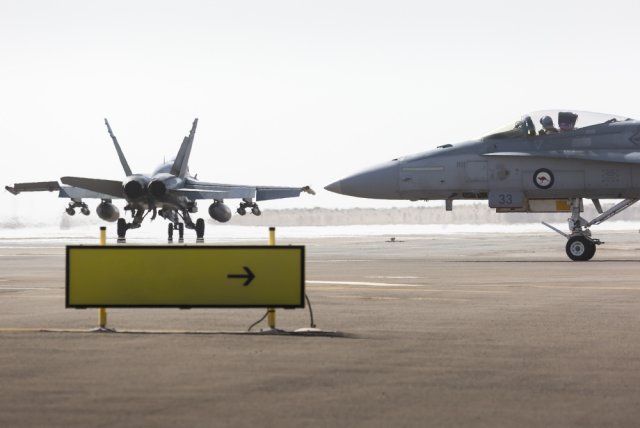Breaking news
RAAF comments Air Task Group last strike missions in Iraq.
| a | |||
|
|
|||
|
World Aviation Defense & Security News - Australia
|
|||
|
|
|||
|
RAAF comments Air Task Group last strike missions in Iraq
|
|||
|
Among the multitude of international voices that can be heard on the combat aircraft radio net above Mosul the Australian accent stands out for many reasons, the Royal Australian Air Force (RAAF) said today. Well regarded for their professionalism, dedication and long-term commitment to defeating Daesh, the Australian voices are a reminder that the RAAF’s Air Task Group is continuing to take the fight to the enemy in support of Iraqi Security Forces (ISF), who are slowly but surely liberating West Mosul.
|
|||
|
|
|||
 RAAF's ATG comprises seven RAAF F/A-18A Hornet fighter aircraft, an E-7A Wedgetail airborne command and control aircraft, and a KC-30A Multi-Role Tanker Transport air-to-air refuelling aircraft RAAF's ATG comprises seven RAAF F/A-18A Hornet fighter aircraft, an E-7A Wedgetail airborne command and control aircraft, and a KC-30A Multi-Role Tanker Transport air-to-air refuelling aircraft(Credit: Commonwealth of Australia/Department of Defence) |
|||
|
|
|||
|
The release of a Precision Guided Munition (PGM) from an F/A18 Hornet aircraft occurs in the blink of an eye, but the work done prior to achieve that moment involves long, complex and thorough preparation.
Commander - Air Task Group, Air Commodore (AIRCDRE) Mike Kitcher said the process undertaken at the coalition’s Combined Air Operations Centre (CAOC) to conduct a strike involves many agencies and processes to deliver munitions where they will achieve their best effect. “Hours prior to jets arriving on-station in West Mosul, the CAOC team begin liaison with coalition strike cells and review intelligence reporting of the area, to identify potential target areas,” AIRCDRE Kitcher said. “Prior to the Hornets launching, Ground Liaison personnel from the Australian Army will brief the aircrew on the situation they can expect on the ground in West Mosul, including expected friendly positions and planned schemes of manoeuvre. “After air to air refuelling our Hornets approach West Mosul and dynamic target requests will be made to the CAOC team. “These will come from the Iraqi Security Forces and coalition support personnel who are on the ground in or near to West Mosul. “They will request support when they are coming under enemy fire or if they identify Daesh targets that are impeding their advance.” ISF and supporting coalition personnel will use a combination of direct observation and intelligence, surveillance and reconnaissance resources to pinpoint enemy targets. This includes Full Motion Video (FMV) feeds from Remotely Piloted Aircraft overhead West Mosul, to refine targets, assess for legality and proportionality, ensure Iraqi government approval and minimise the risk to civilians before making a strike request. Australian Hornets carry a variety of weapons, including Low Collateral Damage weapons, referred to as LOCO by the airmen, to ensure maximum flexibility when destroying valid targets while minimising the risk of harming civilians and property. “Our weapons are very precise,” AIRCDRE Kitcher said. “We use a range of weapons and in West Mosul a lot of those have been LOCO bombs because of the nature of the terrain. “There are lots of old buildings very close together there.” To date the Air Task Group have dropped in excess of 1,860 munitions from approximately 2,300 Hornet sorties, ably supported by 990 KC-30A tanker sorties transferring over 75 million pounds of fuel and 340 E-7A-Wedgetail sorties conducting control of all air operations in the battlespace. Number 1 Squadron and their Super Hornets have recently taken over from Number 77 Squadron in the strike role. This sees the Super Hornets return to theatre for the second time since 2015 and the completion of more than two years of successful continuous operations from the Classic Hornets from Number 3, 75 and 77 Squadrons. |
|||



















